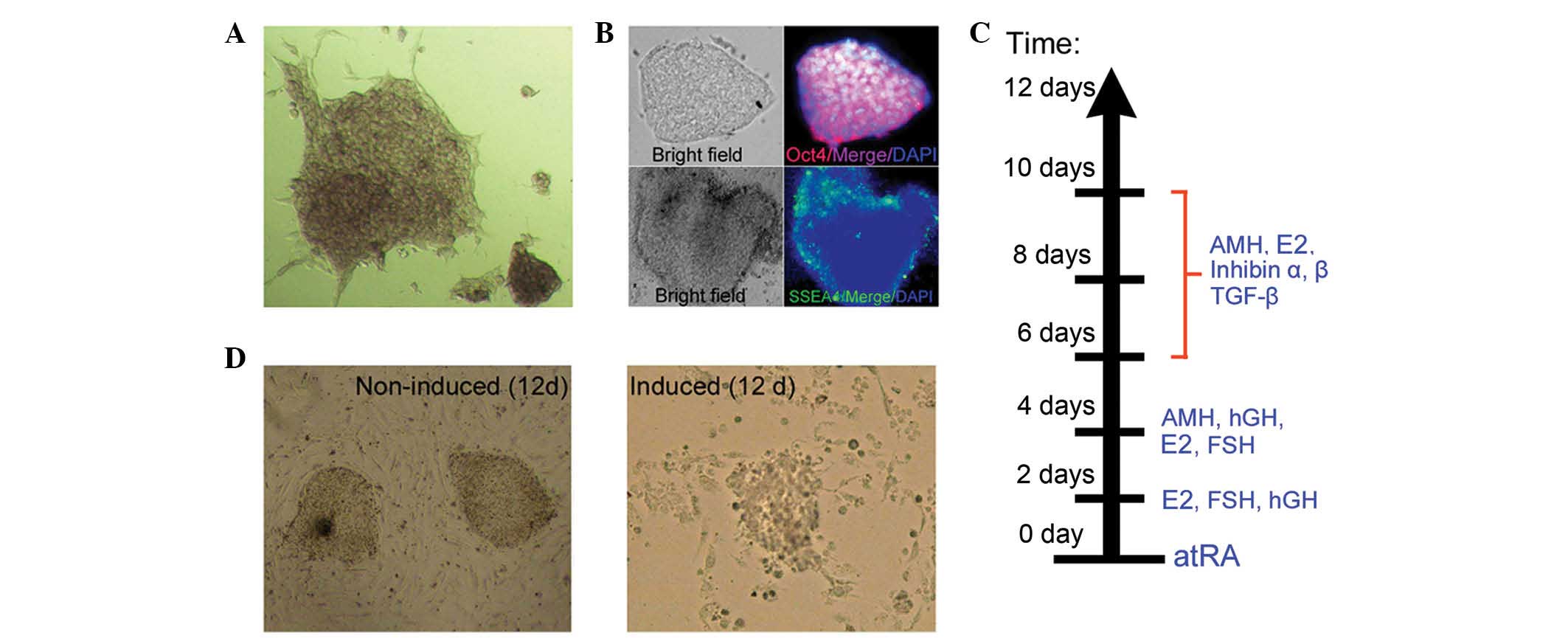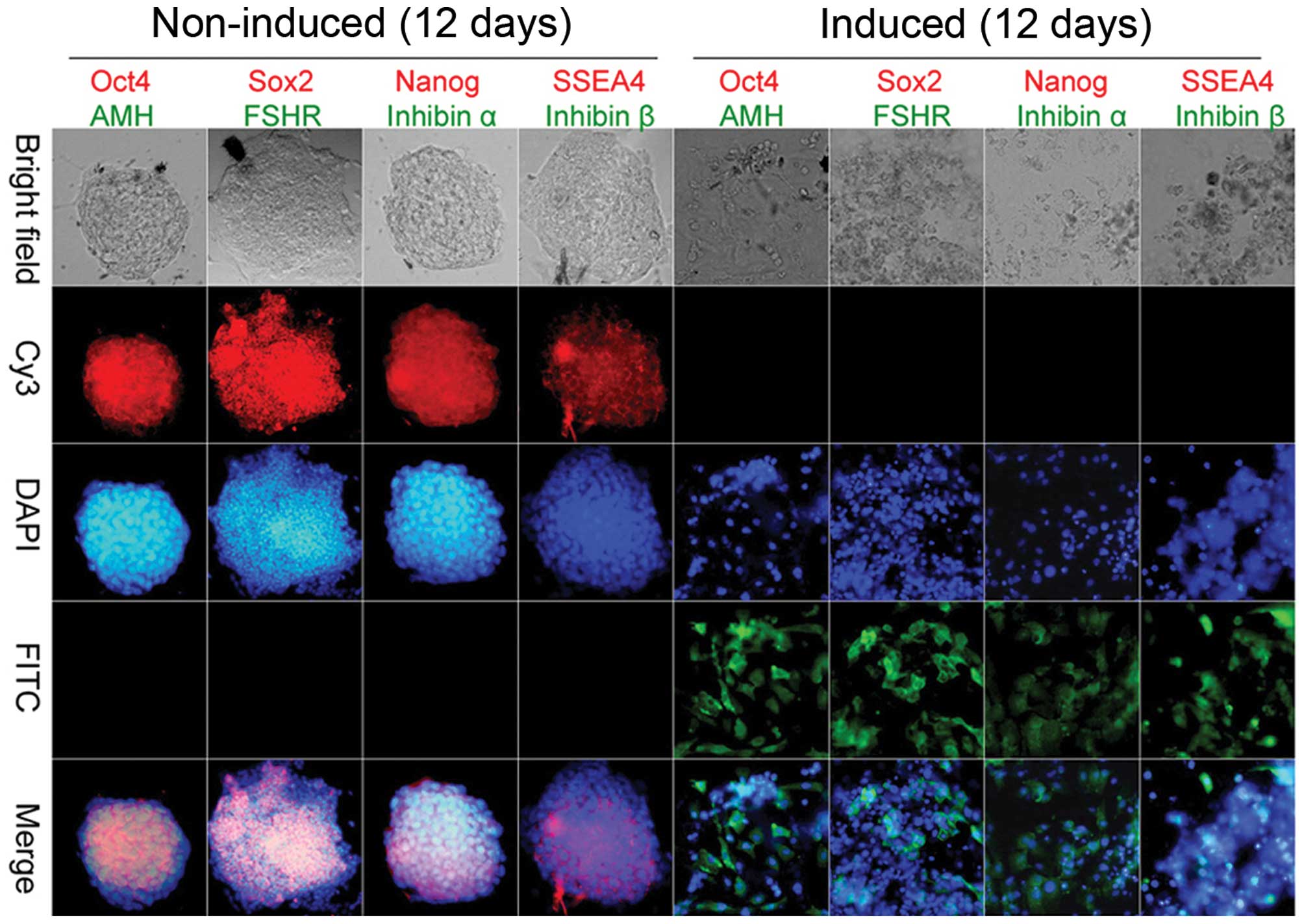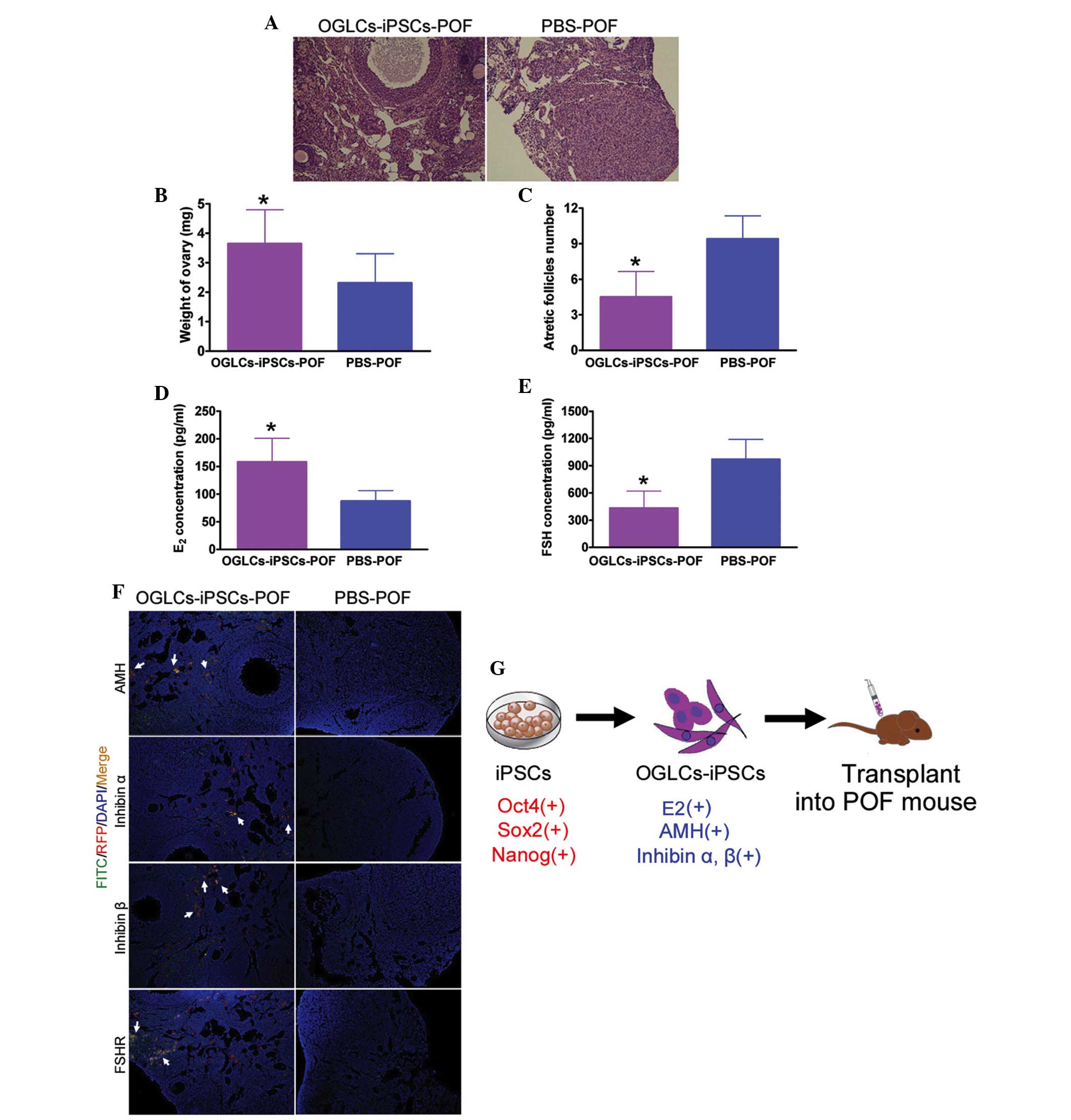Transplantation of ovarian granulosa‑like cells derived from human induced pluripotent stem cells for the treatment of murine premature ovarian failure
- Authors:
- Published online on: April 26, 2016 https://doi.org/10.3892/mmr.2016.5191
- Pages: 5053-5058
-
Copyright: © Liu et al. This is an open access article distributed under the terms of Creative Commons Attribution License.
Abstract
Introduction
Premature ovarian failure (POF) occurs in women before the age of 40, and is characterized by amenorrhea, infertility, low estrogen levels, high gonadotropin levels and a lack of mature follicles (1–4). POF is a common cause of female infertility, the pathogenesis of which is complex. Various defects, including genetic mutations, autoimmune disorders, infections and endocrine dysfunction may result in POF (1–4). Furthermore, patients with POF often exhibit abnormal karyotypes, follicle-stimulating hormone (FSH) abnormalities, autoimmune ovarian failure and ovarian reserve depletion (1–4). The mechanisms underlying POF are largely unknown; however, previous studies have demonstrated that a decline in ovarian reserve is closely associated with the occurrence and development of POF (1–4). Apoptosis of ovarian granulosa cells (OGCs) is an important mechanism underlying the decline of ovarian reserve and function (DORF). OGCs have a supporting and estrogen-mediated regulatory role in the maturation and development of oocytes, and maintain hormonal balance in the ovarian niche, in order to promote oocyte maturation via autocrine and paracrine mechanisms (1–4). Previous studies have indicated that when OGCs undergo a certain degree of apoptosis, ovarian atresia is stimulated, which leads to DORF and POF (2–4). Therefore, in order to maintain ovarian function, oocyte viability and normal ovulation, high quality OGCs are required. In 2006, Takahashi and Yamanaka reported that induced pluripotent stem cells (iPSCs) could be induced to differentiate from mouse fibroblasts via the addition of four transcription factors: SRY (sex determining region Y)-box 2 (Sox2), octamer-binding transcription factor 4 (Oct4), Kruppel-like factor 4 and c-Myc (5). iPSCs share salient characteristics with embryonic stem cells; however, they are generated by reprogramming somatic cells through the forced expression of key transcription factors (2,3,5–9). iPSCs are capable of self-renewal and pluripotent differentiation, and express specific biomarkers, including stage-specific embryonic antigen-4 (SSEA), Oct4, Sox2 and Nanog. In addition, iPSCs express alkaline phosphatase (AKP) and telomerase at high levels (5,9). iPSCs not only provide a valuable model for the in vitro study of the regulation and underlying mechanisms of cell development, but also provide abundant material for cellular genetic research (2,3,5–9). In our previous study, microRNA-17-3p was used to guide the differentiation of human iPSCs into hormone-sensitive ovarian surface epithelium (OSE)-like cells in vitro. Ovarian weight and plasma estradiol (E2) levels were increased over time following transplantation of these OSE-like cells into a mouse model of POF. Furthermore, these OSE-like cells survived within the POF mouse ovaries for ≥14 days, and expressed cytokeratin 7 and estrogen receptor β proteins (3). These findings suggested that iPSCs may provide a significant investigational resource for emerging concepts in cell therapy and regenerative medicine by exploitation of their pluripotent characteristics. In the present study, human iPSCs were induced to differentiate into ovarian granulosa-like cells (OGLCs) in vitro. Subsequently, these cells were transplanted into POF mice. The present study aimed to evaluate the therapeutic potential of such cells for the treatment of POF at the pathological and molecular level.
Materials and methods
Human iPSCs culture and differentiation
DYR0100 human iPSCs (SCSP-1301) were obtained from Professor Xiaoyan Ding (Stem Cell Bank, Chinese Academy of Sciences, Shanghai, China). All experiments using DYR0100 iPSCs were approved by the Shanghai University of Traditional Chinese Medicine Research Ethics Board (Shanghai, China). The DYR0100 iPSCs were cultured in Dulbecco's modified Eagle's medium:F12 (1:1) supplemented with 15% KnockOut™ Serum Replacement, 1 mM sodium pyruvate, 2 mM L-glutamine, 0.1 mM nonessential amino acids, 0.1 mM beta-mercaptoethanol, penicillin (25 U/ml)-streptomycin (925 mg/ml), Reconstituting Human Basic Fibroblast Growth Factor (15 ng/ml), Reconstituting Human Epidermal Growth Factor (15 ng/ml). The aforementioned cell culture reagents were purchased from Gibco (Thermo Fisher Scientific, Inc., Waltham, MA, USA). Cells were incubated in a humidified incubator containing 5% CO2 at 37°C. DYR0100 iPSCs were induced to differentiate into OGLCs for 12 days, according to a multistage protocol using appropriate cell growth factors and hormones (Table I). Briefly, the iPS cells were stimulated with all-trans-retinoic acid (atRA) for 48 h, then atRA was removed. The iPS cells were cultured in fresh medium supplemented with E2, FSH and human growth hormone (hGH) for 48 h. The iPS cells were then cultured in fresh medium supplemented with anti-Müllerian hormone (AMH), estradiol, FSH and hGH for 48 h. Finally, the iPS cells were cultured in fresh medium supplemented with AMH, estradiol, inhibin α, inhibin β and transforming growth factor-β for 96 h.
Murine model of POF and in vivo xenograft experiments
As described in our previous studies (2–4), hebetic female C57BL/6 mice (n=30; age, 5 weeks) were obtained from the Shanghai University of Traditional Chinese Medicine with approval from the Institutional Animal Care and Use Committee. To generate a murine model of POF, the mice were administered a single intraperitoneal injection of 70 mg/kg cyclophosphamide (Sigma-Aldrich, St. Louis, MO, USA). The mice were divided into two groups: A negative control group (n=15) treated with phosphate-buffered saline (PBS), and an experimental group (n=15) transplanted with iPSC-derived OGLCs. A total of 1 week after the POF models were established, each mouse received an injection of 50 µl cells (~1×107 cells/µl), which were stained with DiI red fluorescent dye (Beyotime Institute of Biotechnology, Hangzhou, China), or 50 µl PBS. The final experiments in both groups were conducted 21 days post-transplantation. All mice were sacrificed by cervical dislocation following this treatment and additional experiments were conducted.
AKP assay
An AKP assay kit (Beyotime Institute of Biotechnology) was conducted, according to the manufacturer's protocol. Briefly, the cells were washed twice with PBS and fixed in 4% paraformaldehyde (Sigma-Aldrich) for 20 min. Dye solution was added to the cells, which were incubated at 37°C for 60 min until the AKP-positive cells were stained deep blue. The staining reaction was terminated following the addition of PBS. Digital images were captured using a fluorescence microscope (DMI3000; Leica Microsystems, Inc., Buffalo Grove, IL, USA).
Immunofluorescent staining
As previously described (3,4), the cultured cells or ovarian tissue sections were washed three times with PBS and were fixed with 4% paraformaldehyde for 30 min. After blocking with blocking solution (Beyotime Institute of Biotechnology), the cells were incubated with primary antibodies (Table II) overnight at 4°C, followed by a 30 min incubation with cyanine 3- or fluorescein isothiocyanate-conjugated goat anti-rabbit immunoglobulin G antibodies (1:200; cat. no. C0992; Sigma-Aldrich) and 5 µg/ml 4′,6-diamidino-2-phenylindole (Sigma-Aldrich) at room temperature. Subsequently, the cells and tissues were thoroughly washed with Tris-buffered saline containing 0.5% Tween-20 (Sigma-Aldrich) and were visualized by fluorescence microscopy (DMI3000; Leica Microsystems, Inc.).
Hematoxylin-eosin (H&E) staining
As previously described (3,4), fresh ovarian tissues were washed three times with PBS and were fixed with 4% paraformaldehyde for 30 min. The tissue specimens were then dehydrated in a graded ethanol series, vitrified in xylene, and paraffin embedded. Serial 6-µm sections were prepared and stained with H&E. Images were captured using a DMI3000 microscope (Leica Microsystems, Inc.).
Enzyme-linked immunosorbent assay (ELISA)
Mouse E2 and FSH ELISAs (Shanghai XiTang Biotechnology Co., Ltd., Shanghai, China) were conducted according to the manufacturer's protocols and our previous studies (3,4). Mouse blood plasma was obtained by retro-orbital blood collection (4). Briefly, a microhematocrit tube (BD Biosciences, Franklin Lakes, NJ, USA) was inserted into the mouse lateral canthus at 30 degree angle to the side of the head. Approximately 100 µl blood was collected from each mouse into heparin-coated blood collection tubes (BD Biosciences). Mouse blood was centrifuged at 453 × g at 4°C for 10 min and the supernatant was collected. Briefly, 100 µl mouse E2 or FSH standards at the following concentrations: E2, 8,000, 4,000, 2,000, 1,000, 500, 250 and 125 pg/ml; FSH, 10,000, 5,000, 2,500, 1,250, 625, 312 and 156 pg/ml, or diluted mouse plasma were added to anti-E2 or anti-FSH pre-coated microtest wells and were incubated for 60 min. The plates were then washed three times with PBS, and horseradish peroxidase-conjugated antibodies were added, followed by an enzymatic substrate. Optical absorbance was determined at a wavelength of 450 nm using a BioTek Synergy Mx plate reader (BioTek Instruments, Inc., Winooski, VT, USA).
Statistical analysis
Each experiment was performed as least three times, and results are presented as the mean ± standard error of the mean. Data was analyzed using GraphPad Prism software (version 5.0; GraphPad Software, Inc., La Jolla, CA, USA). Where applicable, differences were evaluated by Student's t-test. P<0.05 was considered to indicate a statistically significant difference.
Results
iPSCs can be induced to differentiate into OGLCs in vitro
Pluripotent stem cell biomarkers were detected prior to induction. Cellular immunostaining detected high expression levels of AKP, Oct4 and SSEA-4 (Fig. 1A and B). Subsequently, various cell growth factors (transforming growth factor-β and human growth hormone) and hormones [E2, anti-Müllerian hormone (AMH), inhibin α and inhibin β] were used to induce iPSCs to differentiate into OGLCs at various time points (Fig. 1C). Following 12 days of induction, morphological observations indicated that the original clone-like iPSCs had successfully differentiated into fibroblast-like cells (Fig. 1D). Cell immunofluorescence indicated that prior to induction, iPSCs expressed high levels of pluripotent stem cell markers, including Oct4, Sox2, Nanog and SSEA-4, but did not express OGC markers, including AMH, FSH receptor (FSHR), inhibin α and inhibin β. Conversely, following induction, the expression levels of OGC markers were elevated in granulosa-like cells derived from iPSCs (Fig. 2). These results suggest that iPSCs may be induced to differentiate into granulosa-like cells in vitro, following treatment with a combination of hormones and growth factors.
OGLCs derived from iPSCs can reverse POF in mice
A total of 21 days post-transplantation the mice were sacrificed. In the control group (PBS-POF), ovarian pathological analysis indicated that normal follicles were almost absent. Ovarian stromal tissue and OGCs exhibited hallmarks of apoptosis and atrophy. Furthermore, ovarian tissue presented varying degrees of bleeding and serious follicular atresia (Fig. 3A). However, compared with the PBS-POF group, in the experimental group (OGLCs-iPSCs-POF), ovarian pathological analysis revealed that ovarian tissue contained some normal mature follicles, with a significant reduction in the numbers of atretic follicles. In addition, the growth state of the OGCs was markedly improved (Fig. 3A). Ovarian tissue weight was increased in the OGLCs-iPSCs-POF group compared with in the PBS-POF group (P<0.05; Fig. 3B). The number of atretic follicles in the OGLCs-iPSCs-POF mice was reduced, as compared with in the PBS-POF mice (P<0.05; Fig. 3C). Furthermore, detection of hormone levels in murine peripheral blood samples indicated that the levels of E2 were elevated in the OGLCs-iPSCs-POF group, whereas the levels of FSH were decreased (Fig. 3D and E; Table III). Furthermore, in the OGLCs-iPSCs-POF group, immunofluorescence indicated that iPSC-derived OGLCs transplanted into POF mice (visualized by red fluorescence) expressed OGC biomarkers (AMH, inhibin α, inhibin β, FSHR; green fluorescence) in ovarian tissue (Fig. 3F). These results suggest that iPSCs-derived OGLCs were capable of repairing ovarian injury and enhancing ovarian function.
Discussion
DORF is a typical characteristic and initial stage of POF (1). Ovarian reserve and function encapsulates the quantity and quality of follicles in the ovarian cortex, follicular growth capacity, ovarian development and oocyte formation (1–4). In addition, ovarian reserve and function is a measure of female reproductive endocrine functionality and fertility potential (1–4). The quality of OGCs directly influences ovarian reserve and function, and poor quality OGCs may eventually lead to the occurrence of POF (1–4). OGCs are the most immediate factor influencing ovarian function and follicular maturation (2–4). The present study aimed to determine whether ovarian tissue functionality can be enhanced or even restored following transplantation of OGCs (1–4). The present study evaluated techniques to induce differentiation of iPSCs into OGLCs in vitro. The results indicated that iPSCs could be induced to differentiate into OGLCs following treatment with numerous cell growth factors and hormones. Post-induction, iPSC-derived OGLCs exhibited the morphology of fibroblast cells, rather than that of embryonic stem cell clones. Furthermore, iPSC-derived OGLCs strongly expressed OGC biomarkers, but did not express markers characteristic of iPSCs. Subsequently, iPSC-derived OGLCs were transplanted into POF mice, and were revealed to express OGC biomarkers in ovarian tissue, improve ovarian tissue maturation status and further maintain follicular growth. These findings suggested that iPSC-derived OGLCs may be capable of re-establishing ovarian function. In addition, although the number of OGLCs observed in the ovarian tissues of POF mice were low, they served a role in ovarian repair. Growth hormones are crucial for the maintenance of ovarian follicular development, including AMH, inhibin α and inhibin β. The prevalence and maturation of follicles is not only modulated by the pituitary gonadal axis, but is also influenced by specific cytokines in the ovarian niche. AMH, inhibin α and inhibin β are members of the transforming growth factor-β superfamily, which are secreted by OGCs and exert an important role in ovarian maturation and recruitment. In addition, iPSCs-derived OGLCs did not induce teratoma formation and were relatively quiescent in vivo in the POF mice (Fig. 3G).
The results of the present study indicated that iPSC-derived OGLCs exhibited complete differentiation in vitro and were stable when transplanted into normal mice. In conclusion, the present study provides a novel insight regarding the treatment of POF. iPSC-derived OGLCs were able to enhance ovarian function in a murine model of POF, resulting in a reversal of ovarian dysfunction and thereby promoting follicular maturation.
Acknowledgments
The present study was supported by a grant from the National Natural Science Foundation of China (grant no. 81273794) to Jin Zheng. In addition, this work was supported by grants from the National Natural Science Foundation of China (grant no. 81202811), the Project funded by China Postdoctoral Science Foundation (grant no. 2014M550250), and the Shanghai Municipal Health Bureau Fund (grant no. 20124320) to Te Liu. The authors declare no potential conflicts of interest.
References
|
Vujović S, Ivović M, Tancić-Gajić M, Marina L, Barać M, Arizanović Z, Nenezić A, Ivanisević M, Micić J, Sajić S and Micić D: Premature ovarian failure. Srp Arh Celok Lek. 140:806–811. 2012. View Article : Google Scholar | |
|
Liu T, Huang Y, Guo L, Cheng W and Zou G: CD44+/CD105+ human amniotic fluid mesenchymal stem cells survive and proliferate in the ovary long-term in a mouse model of chemotherapy-induced premature ovarian failure. Int J Med Sci. 9:592–602. 2012. View Article : Google Scholar : PubMed/NCBI | |
|
Liu T, Qin W, Huang Y, Zhao Y and Wang J: Induction of estrogen-sensitive epithelial cells derived from human-induced pluripotent stem cells to repair ovarian function in a chemotherapy-induced mouse model of premature ovarian failure. DNA Cell Biol. 32:685–698. 2013. View Article : Google Scholar : PubMed/NCBI | |
|
Liu T, Huang Y, Zhang J, Qin W, Chi H, Chen J, Yu Z and Chen C: Transplantation of human menstrual blood stem cells to treat premature ovarian failure in mouse model. Stem Cells Dev. 23:1548–1557. 2014. View Article : Google Scholar : PubMed/NCBI | |
|
Takahashi K and Yamanaka S: Induction of pluripotent stem cells from mouse embryonic and adult fibroblast cultures by defined factors. Cell. 126:663–676. 2006. View Article : Google Scholar : PubMed/NCBI | |
|
Kiskinis E and Eggan K: Progress toward the clinical application of patient-specific pluripotent stem cells. J Clin Invest. 120:51–59. 2010. View Article : Google Scholar : PubMed/NCBI | |
|
Liu T, Chen Q, Huang Y, Huang Q, Jiang L and Guo L: Low microRNA-199a expression in human amniotic epithelial cell feeder layers maintains human-induced pluripotent stem cell pluripotency via increased leukemia inhibitory factor expression. Acta Biochim Biophys Sin (Shanghai). 44:197–206. 2012. View Article : Google Scholar | |
|
Liu T, Cheng W, Huang Y, Huang Q, Jiang L and Guo L: Human amniotic epithelial cell feeder layers maintain human iPS cell pluripotency via inhibited endogenous microRNA-145 and increased Sox2 expression. Exp Cell Res. 318:424–434. 2012. View Article : Google Scholar | |
|
Liu T, Zou G, Gao Y, Zhao X, Wang H, Huang Q, Jiang L, Guo L and Cheng W: High efficiency of reprogramming CD34+ cells derived from human amniotic fluid into induced pluripotent stem cells with Oct4. Stem Cells Dev. 21:2322–2332. 2012. View Article : Google Scholar : PubMed/NCBI |












